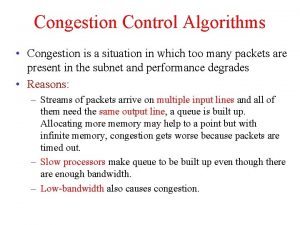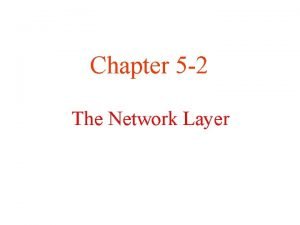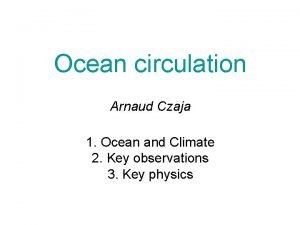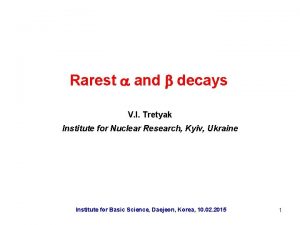Rarest First and Choke Algorithms are Enough Arnaud





























- Slides: 29

Rarest First and Choke Algorithms are Enough Arnaud LEGOUT G. Urvoy-Keller and P. Michiardi INRIA, Sophia Antipolis Institut Eurecom France

Bit. Torrent Overview cool. Content. torrent Web server random peer set Tracker cool. Content. xvid P 1 P 2 P 3 2

Peer and Piece Selection q At the core of any P 2 P protocol q Peer Selection § Maximize capacity of service § Foster reciprocation and prevent free riders q Choice of the peers to upload to § Efficiency criteria 3

Peer and Piece Selection q Piece selection § Which pieces to download from peers § Should guarantee a high piece diversity • Always find an interesting piece in any other peer § Do not bias peer selection 4

Choke and Rarest First Algorithms q Choke algorithm § Local and remote peers § Choke and unchoke § Leechers: upload to the peers (unchoke) from which we are downloading the fastest • Reevaluate periodically (10 s) § Optimistic unchoke • Reevaluate periodically (30 s) § 3 unchoke + 1 optimistic unchoke § Seeds: refer to the paper 5

Choke and Rarest First : 1 Algorithms : 1 : 2 : 1 q Rarest first algorithm § Choose the pieces that are locally rarest § For short: rarest first 6

Some Real Numbers q. Torrent characteristics § Torrent size: from a few peers to 100 000 peers • popular torrents: between 10 000 and 50 000 peers § Content size: from a few k. B to 4 GB • TV series: 300 MB, Movie: 600 MB, DVD image: 4 GB § Piece size: {256, 512, 1024} k. B • Typical case: 1000 pieces for a content § Peer set size: 80 peers 7

Why Studying Bit. Torrent Peer and Piece Selection? q. Implemented in all Bit. Torrent clients § Very popular protocol § Large fraction of the internet traffic § Focus on efficient data dissemination q. Very simple algorithms § Fast to compute § Minimal state § Easy to implement 8

Why Studying Bit. Torrent Peer and Piece Selection? q. But, doubts on the efficiency q. Rarest first § Poor pieces diversity (in specific scenarios) resulting in low efficiency q. Proposed solutions § Source coding: Bullet’ (Kostic et al. ) § Network coding: Avalanche (Gkantsidis et al. ) § Refer to the paper for a discussion on those solutions 9

Why Studying Bit. Torrent Peer and Piece Selection? q. Choke algorithm § Unfair § Favors free riders q. Proposed solutions § Based on strict byte reciprocation q. Do we see the claimed deficiencies in real torrents? 10

Outline q. Background and motivation q. Methodology q. Results § Rarest first algorithm § Choke algorithm q. Conclusion 11

Experiments q. Instrumented a Bit. Torrent client (mainline) § Log each message sent or received, and internal state § Use default parameters (20 k. B/s upload) q. Connected this client to real torrents § Single client to be unobtrusive • No assumption on the other real peers § Connected to 80 peers selected at random q 8 hours experiments per torrent 12

Choice of the Torrents q. Real torrents (26 in the paper) § Both free and copyrighted contents • TV series, movies, live concerts, softwares § Large variety in the number of seeds and leechers • • 0 seed, 66 leechers 1 seed, 1411 leechers (low seed to leecher ratio) 160 seeds, 5 leechers 12612 seeds, 7052 leechers 13

Outline q. Background and motivation q. Methodology q. Results § Rarest first algorithm § Choke algorithm q. Conclusion 14

Peer Interest q Peer X is interested in peer Y if peer Y has at least 1 piece that peer X does not have 15

Peer Availability q Peer availability of Y (according to peer X) q Peer availability=1 § X is always interested in peer Y q Peer availability=0 § X is never interested in peer Y q Peer availability=0. 5 § X interested in peer Y half of the time peer Y has 16 spent in the peer set of peer X

Ideal Piece Selection q. For each peer X the peer availability of all peers Y (according to X) must be 1 § How far is rarest first to an ideal piece selection strategy? 17

Increasing peer availability Peer Availability High peer availability 0 to 1 seed 3 to 12612 seeds th 80 Low peer availability 50 th 20 th Increasing number of seeds 18

Deeper Look at Torrent 8 36 k. B/s q. The initial seed has not yet sent one copy of each piece (transient state) 1 seed, 861 leechers, 863 pieces 19

Transient State q. Torrents with poor peer availability are in transient state § The initial seed has not yet sent one copy of each piece § Some pieces are rare (only present on the initial seed) q. Rare pieces served at the upload speed of the seed, other pieces served with a capacity of service increasing exponentially 20

Transient State q. This is a provisioning problem, not a piece selection problem § Cannot significantly improve on rarest first q. Rarest first is an efficient piece selection strategy on real torrents § Network coding theoretically optimal in all cases, but more complex § Rarest first as efficient as network coding on real torrents (availability close to 1), but much simpler • Large peer set (80) 21

Outline q. Background and motivation q. Methodology q. Results § Rarest first algorithm § Choke algorithm q. Conclusion 22

Tit-for-Tat Fairness q. Choke algorithm fairness challenged in several studies § Does not guarantee strict byte reciprocation § Based on a short term throughput estimation q. Tit-for-tat Fairness § Peer A can download data from peer B if: (bytes downloaded from B - bytes uploaded to B) < threshold 23

Tit-for-Tat Fairness q. Tit-for-tat fairness problems § Does not take into account extra capacity • Seeds cannot download • Leechers may have asymmetric capacity § May lead to deadlock, as it is complex to find appropriate thresholds q. Need for another notion of fairness 24

Peer-to-Peer Fairness q. Two criteria (inspired from Bit. Torrent) § A leecher must not receive a higher service than any other leecher that contributes more than himself • Do not steal capacity if it is used by someone else • No strict reciprocation § A seed must give the same service time to each leecher • Distribute evenly spare capacity 25

Peer-to-Peer Fairness q. Excess capacity is used q. No need to maintain thresholds or enforce strict reciprocation q. Foster reciprocation and penalize free riders § Free riders cannot receive a higher capacity of service than contributing peers 26

Fairness of the Choke Algorithm LS 1 -5 6 -10 1 -5 11 -15 16 -20 q Good reciprocation for torrents in steady state q Choke algorithm biased by poor peer availability 21 -25 26 -30 for torrents in transient state 6 -10 11 -15 16 -20 21 -25 26 -30 27

Conclusion q. Rarest first guarantees a high peer availability § No need for more complex solution in the monitored torrents § Transient state is a seed provisioning issue q. Choke algorithm is fair and fosters reciprocation q. Rarest first and choke algorithms are enough on real torrents § Simple and efficient on real torrents 28

Thank you Questions? Instrumented client available at: http: //www-sop. inria. fr/planete/Arnaud. Legout/Projects/p 2 p_cd. html 29
 Choke bit
Choke bit Insidan region jh
Insidan region jh The rarest and oldest type of geothermal power plant
The rarest and oldest type of geothermal power plant To live is the rarest thing in the world book
To live is the rarest thing in the world book Im good enough i'm smart enough and doggone it
Im good enough i'm smart enough and doggone it Our failing schools enough is enough
Our failing schools enough is enough Much vs many
Much vs many Our failing schools enough is enough summary
Our failing schools enough is enough summary Vhf/uhf choke balun
Vhf/uhf choke balun Gm3sek common mode choke
Gm3sek common mode choke Choke packet in congestion control
Choke packet in congestion control General principles of congestion control
General principles of congestion control Hop by hop choke packet
Hop by hop choke packet Lesson 2 human geography of the arabian peninsula
Lesson 2 human geography of the arabian peninsula Hop by hop choke packet
Hop by hop choke packet Toroidi
Toroidi Rf choke
Rf choke Low voltage three phase choke coil filter reactor in pfc
Low voltage three phase choke coil filter reactor in pfc Amputasyon ppt
Amputasyon ppt Arnaud ancion
Arnaud ancion Arnaud alcabez
Arnaud alcabez Arnaud ventura
Arnaud ventura Arnaud pasquiers
Arnaud pasquiers Arnaud marsollier
Arnaud marsollier Keith arnaud
Keith arnaud Arnaud venet
Arnaud venet Arnaud czaja
Arnaud czaja Kishore mosaliganti
Kishore mosaliganti Arnaud courgey
Arnaud courgey Babakr al-zibari
Babakr al-zibari

















































